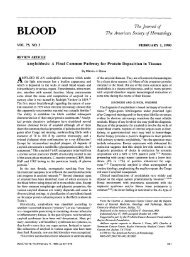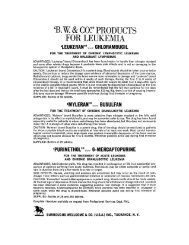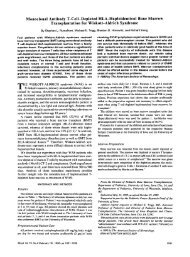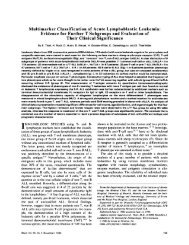From www.bloodjournal.org by guest on April 28, 2015. For personal use only. 50 HJORT AND PAPUTCHIS . - 0 NORMAL RATS 5-- 5 HYPERSPLENIC RATS j 20 S 01 S ‘1 Sc ‘1 8 2 4 6 DAYS AFTER INJECTION FIG. 3.-<strong>Platelet</strong> radioactivity after <strong>in</strong>jection of DFPS2 <strong>in</strong>to normal <strong>and</strong> hypersplenic rats. Each po<strong>in</strong>t represents the average of two rats. The l<strong>in</strong>es are fitted by the method of least squares. In the normal group the slope of the l<strong>in</strong>e corresponds to a half-life of 4.0 days, with 3.1 to 5.6 days as 95 per cent confidence limits. In the hyperspienic group the half-life was 5.0 days. However, to make an analogy, any significant fall of red cell concentration produces a marked <strong>in</strong>crease <strong>in</strong> the erythropoietic rate. Thus, a mild degree of anemia <strong>in</strong> hereditary spherocytosis is associated with erythropoietic rates of five to six times normal,’ <strong>and</strong> mild anemia <strong>in</strong>duced by bleed<strong>in</strong>g results <strong>in</strong> <strong>in</strong>creases of three times normal. Our studies show that no such <strong>in</strong>creased state of platelet turnover is present <strong>in</strong> the hypersplenic rats with thrombocytopenia. S<strong>in</strong>ce platelet production can be <strong>in</strong>creased both <strong>in</strong> normal <strong>and</strong> <strong>in</strong> splenectomized methylcellulose-treated rats,17 our results suggest that the thrombocytopenia was caused by a splenic marrow depression, rather than by <strong>in</strong>creased destruction. SUMMARY 1. A method is described for the isolation of rat platelets. The method gives high yields of platelets with negligible white <strong>and</strong> red cell contam<strong>in</strong>ation. 2. Rat platelets were labeled <strong>in</strong> vivo with radioactive diisopropylfluorophosphate ( DFP32 ) . The platelet life span was the same <strong>in</strong> normal, splenectomized <strong>and</strong> hypersplenic rats. 3. Some problems <strong>in</strong>volved <strong>in</strong> the use of DFPII as a blood cell label are discussed. SUMMARIO IN INTERLINGUA 1. Es describite un methodo pro le isolation de plachettas de ratto. Illo resulta <strong>in</strong> un alter rendimento de plachettas, con negligibile grados de contam<strong>in</strong>ation leuco- e erythrocytic. 2. Plachettas de ratto esseva marcate <strong>in</strong> vivo con biisopropylfluorophosphato
From www.bloodjournal.org by guest on April 28, 2015. For personal use only. PLATELET LIFE SPAN IN RATS 51 a I)lo51)lor0 radioactive ( BFP:i2 ) . Le duration del vita de plachettas ab rattos normal, rattos splenectcmisate, rattos hypersplenic esseva le mesme. 3. Es discutite certe problemas <strong>in</strong>herente <strong>in</strong> le uso de BFP:12 como marca pro cellulas de sangu<strong>in</strong>e. REFERENCES 1. Cronkite, E. P., Bond, V. P., Robertson, J. S., <strong>and</strong> Paglia, D. E.: The survival, distribution <strong>and</strong> apparent <strong>in</strong>teraction with capillary endotheliurn of transfused radiosulfate labeleti platelets <strong>in</strong> the rat. J.Cl<strong>in</strong>.Invest. 36:881, 1957. 2. Reisner, E. H., Jr., Keat<strong>in</strong>g, R. P., Friesen, C. , <strong>and</strong> Loeffier, E. : Stirvival of sodiunl chromate51 labeled <strong>Platelet</strong>s <strong>in</strong> an<strong>in</strong>lals anti man. In Proceed<strong>in</strong>gs of The Sixth Congress of tile International Society of H2matology. New York, Grune & Stratton, 1956, pp. 292-293. 3. Robertson, J. S., sIi<strong>in</strong>e, \V. L., <strong>and</strong> Cohn, S. H.: Label<strong>in</strong>g <strong>and</strong> trac<strong>in</strong>g rat blood platelets with chromium51. Proceed<strong>in</strong>gs of Radioisotope Conference. New York, Academic Press, Inc., 1954, vol. I, 205-208. 4. Odell, T. T., Jr.: Production, life span <strong>and</strong> fate of blood platelets: Studies with radioisotope label<strong>in</strong>g technics. In Proceed<strong>in</strong>gs of The Sixth Congress of tile International Society of Hematology. New York, Grune & Stratton, 196, p. 294. 5. Palmer, J. G., Eichwald, E. J., Cartwright, G. E., <strong>and</strong> \V<strong>in</strong>trobe, I’sI. M.: The experimental production of splenomegaly, anemia <strong>and</strong> leukopenia <strong>in</strong> alb<strong>in</strong>o rats. <strong>Blood</strong> 8:72-80, 1953. 6. Leeksma, C. H. \V., <strong>and</strong> Cohen, J. A.: Determ<strong>in</strong>ation of the life span of human i)lOOti platelets us<strong>in</strong>g labeled diisopropylfluorophosphonate. Invest. 35:964-969, 1956. J.Cl<strong>in</strong>. 7. l’slarsh, D. J., <strong>and</strong> Neale, E.: A colonmetric method for the detection <strong>and</strong> deterni<strong>in</strong>ation of certa<strong>in</strong> acid halide <strong>and</strong> acid anhydride compounds. Chem.& md. 494-495, June 1956. 8. Brecher, G., Schneiderrnan, M., <strong>and</strong> Cronkite, E. P.: The reproducibility <strong>and</strong> constancy of the platelet count. Am.J.Cl<strong>in</strong>.Path. 23:15-26, 1953. 9. Gardner, F. H., Aas, K. A., Cohen, P., <strong>and</strong> Pr<strong>in</strong>gle, J. C.: Investigations of the mechanisms of thrombocytopenia. Cl<strong>in</strong>ical Research Proceed<strong>in</strong>gs 6:199- 200, 1958. 10. Odeil, T. T., Jr., Tausche, F. G., <strong>and</strong> Forth, J. : <strong>Platelet</strong> life span as meastired i)y transfusion of isotopically labeled platelets <strong>in</strong>to rats. Acta Haemat. 13:45-52, 1955. 1 1. Poliycove, NI., Dal Santo, G., <strong>and</strong> Lawrence, J. H. : Simultaneous measurement of erythrocyte, leukocyte, <strong>and</strong> 1)ltelet sunvival <strong>in</strong> normal sill)- jects with t<strong>in</strong>sopropyifluorophosphate ( DFP32 ) . Cl<strong>in</strong>ical Research Proceed<strong>in</strong>gs 6:45-46, 1958. 12. Adelson, E., Rhe<strong>in</strong>gold, J. j., <strong>and</strong> Crosby, \V. H. : Studies of platelet survival by tagg<strong>in</strong>g <strong>in</strong> vico with P3. j.Lab.& Cl<strong>in</strong>.Med. 50:57()-576, 1957. 13. Odell, T. T., Jr., Tausche, F. G., <strong>and</strong> Gude, W. D.: Uptake of radioactive sulfate by eleillents of the 1)100(1 <strong>and</strong> the bone niarnow of rats. Am.J. Physiol. 180:491-494, 1955. 14. Cohen, J. A., <strong>and</strong> \Varr<strong>in</strong>ga, NI. G. P. J.: The fate of p32 labeled diisopropylfluorophosphonate <strong>in</strong> the human body anti its use as a label<strong>in</strong>g agent <strong>in</strong> the study of the turnover of blood plasma <strong>and</strong> red cells. J.Cl<strong>in</strong>.Invest. 33:459-. 467, 1954. 15. Giblett, E. R., Coleman, 1). H., Pirzio- Biroli, G., Donohue, i). Ni., Motuisky, A. G., <strong>and</strong> F<strong>in</strong>ch, C. A. : Erythrok<strong>in</strong>etics. Quantitative measurements of red cell production <strong>and</strong> destruction <strong>in</strong> normal subjects <strong>and</strong> patients with anemia. <strong>Blood</strong> 11:291-309, 1956. 16. Coleman, D. H., Stevens, A. R., Jr., Dodge, H. T., anti F<strong>in</strong>ch, C. A.: Rate of 1)100(1 regeneration after blood loss. A.M.A.Arcb.Int.Med. .92:341- 349, 1953. 17. Matter, M., Hartmann, J. R., Kautz, J., DeMarsh, Q. B., <strong>and</strong> F<strong>in</strong>ch, C. A.: A study of thronbopoiesis <strong>in</strong> <strong>in</strong>duced ectite thmombocytopeni.i. <strong>Blood</strong> 15: 174, 1960.













